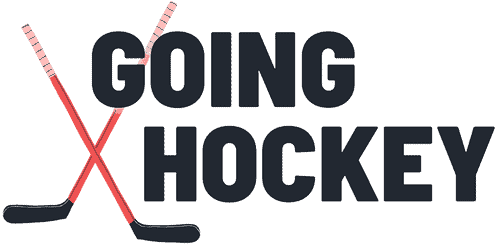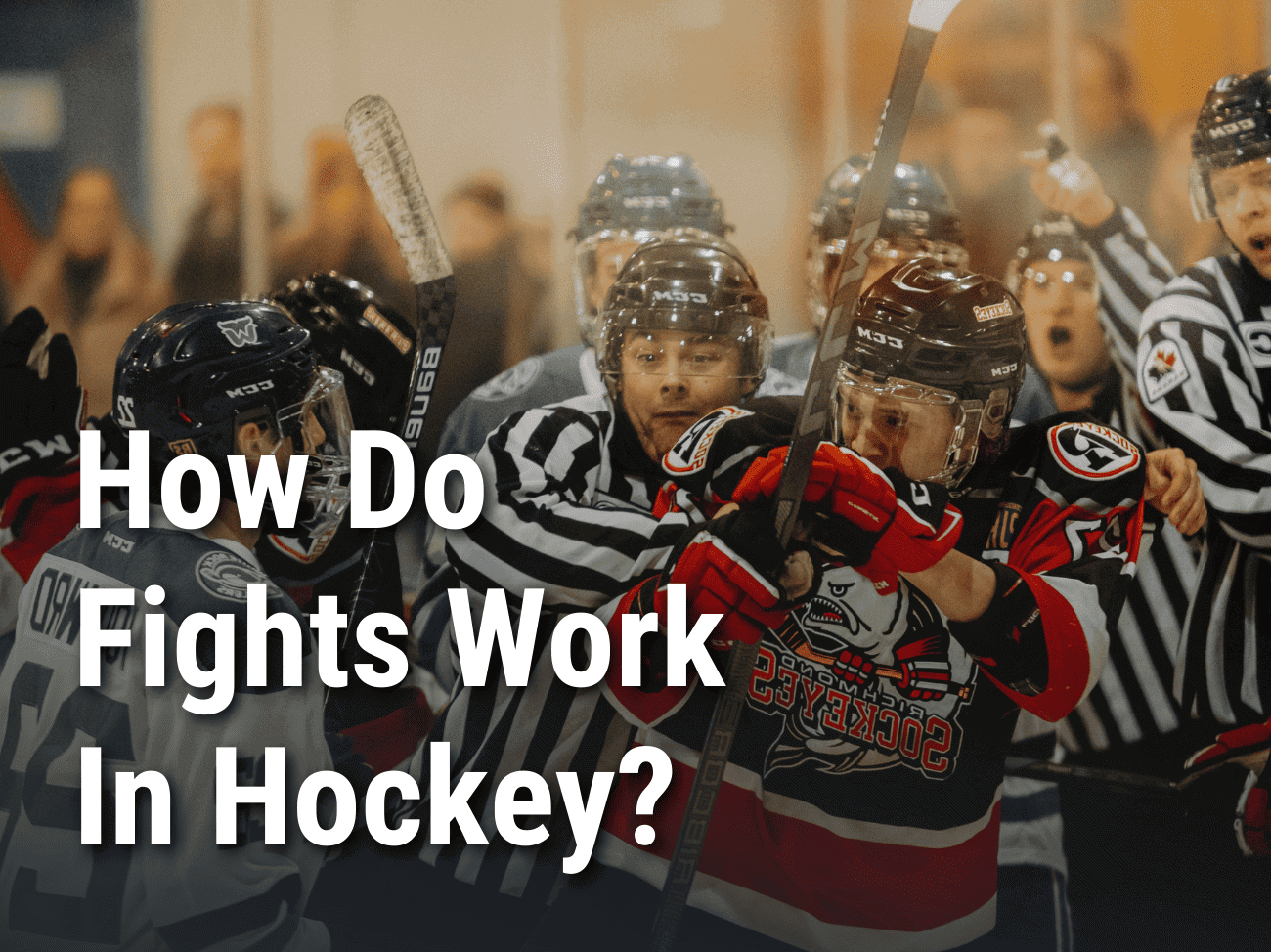Hockey, known for its exhilarating speed, precision, and physicality, has captivated fans around the world for decades. From the bone-crushing checks to the lightning-fast slap shots, hockey is a sport that demands courage, skill, and an unwavering competitive spirit. One aspect that sets hockey apart from other team sports is its acceptance and occasional celebration of on-ice fights.
How do fights work in hockey?
In the NHL, hockey fights work like this:
- Players drop their gloves.
- Players start throwing punches.
- Fight continues until both players are tired out, or they lose balance and fall to the ice.
- Linesmen break up the fight.
- Both players get a 5 min major penalty. Both teams maintain 5 vs. 5 play on the ice.
Sometimes an “Instigator Penalty” is handed out, in addition to the fighting penalty. An instigator penalty results in an extra 2 min penalty for a team, and under certain circumstances, a $10,000 fine for the Coach.
How Do Fights Work In Hockey

Dropping the Gloves
Not all hockey fights follow the same sequence. However, most fights will begin with two players dropping their gloves. Dropping the gloves is an integral part of how fights work in hockey.
Dropping the gloves is a universal sign in hockey that you are trying to fight. There is an unwritten rule in hockey, that unless both players drop their gloves, neither player will start throwing punches. This rule, however, isn’t always upheld.
Sometimes, if an opposing player has something particularly egregious, an allied player will drop their gloves and start throwing punches, regardless of whether the other player is trying to fight. In most instances though, the opposing player will see this coming and will either, also drop their gloves, or turtle to the ice.

If a player drops their gloves, but the opposing player doesn’t, the player who dropped their gloves will be given a 2 min penalty, causing their team to be shorthanded (5 vs. 4). Because of this, players are often careful of dropping their gloves when fighting.
Some players (dishonorable players) will bait opponents by pretending to throw their gloves off. They’ll throw their hands down – while keeping their gloves on – causing the opponent to throw their gloves off. This is however fairly rare.
Since dropping your gloves can get you penalized hockey players will often shake their gloves or drop their gloves halfway, to try and instigate a fight.
Throwing Punches
After dropping the gloves players will usually first grab onto each other’s jerseys, after which they will start throwing punches. Grabbing the jerseys is a key part of how fights work in hockey.
In most cases, players will hold the opponent’s jersey with their left hand while throwing punches with their right. Even lefties will often start fights by throwing punches with their right hand.

Fights that occur between a lefty and righty usually won’t last as long. This is mainly for two reasons:
- Less balance
- Harder punches
When a righty and lefty decide to both throw punches with their dominant hand, the grappling between them becomes much less steady. A big, missed swing will usually result in one or both players falling. Additionally, the punches thrown between lefties and righties will usually hit a lot harder as both players’ faces are completely exposed to one another’s punches.
Fight Continues
The next sequence in understanding how fights work in hockey is understanding how they come to an end. Hockey fights will continue until one of the players falls, or both players tire out.
Fighting on skates is very difficult as players must maintain balance while throwing punches and dodging swings. Often, players will throw a punch, miss, lose balance, and fall to the ice – at which point the fight is over. It is rare – but it does happen – that a player takes a hard punch to the head or face causing them to fall to the ice.

If players don’t lose balance in a fight, the fight comes to an end when the players tire out. Fighting is the most physically demanding and tiring thing you can do in hockey. As a result, most fights will last no more than ~30sec. The fights will usually be even shorter if both players are at the end of their shifts. Players may sometimes not even fight and simply tie up, or hug, the opponent if they know they are too tired to fight.
Linesmen Breakup The Fight
Linesmen finally breaking up the fight is one of the last components in how fights work in hockey.
After the players are all punched out, or they have fallen to the ice, the linesmen will quickly move in to separate the players. According to rule 46.7 of the NHL Rule Book, any player who attempts to continue to fight after the linesmen have deemed the fight to be over will, at the minimum receive a 10 min misconduct penalty. It is also possible that the player receives a game misconduct and is ejected from the game.
Both Players Receive 5 Min Major Penalties
One of the most important facets of how fights work in hockey is what penalties are given to the fighters.

Per Rule 64.14 of the NHL Rule Book, any player who fights receives a 5 min major penalty. If there is no “instigator penalty” dished out, both teams will maintain 5 players on the ice. If there is an instigator penalty handed out, then one of the teams will be shorthanded.
What Is The Instigator Penalty In Hockey
One critical aspect of understanding how fights work in hockey is understanding the “instigator rule.”
The following is the “Instigator Penalty”, taken directly from the Official NHL Rule Book:
Rule 64.11 – Instigator
An instigator of an altercation shall be a player who by his actions or demeanor demonstrates any/some of the following criteria:
- Distance traveled
- Gloves off first
- First punch thrown
- Menacing attitude or posture
- Verbal instigation or threats
- Conduct in retaliation to a prior game (or season) incident
- Obvious retribution for a previous incident in the game or season

A player who is deemed to be the instigator of an altercation shall be assessed:
- Major penalty for fighting (5 min)
- Instigating minor penalty (2 min)
- Ten-minute misconduct (10 min)
If the same player is deemed to be the instigator of a second altercation in the same game, he shall be assessed:
- Major penalty for fighting (5 min)
- Instigating minor penalty (2 min)
- Ten-minute misconduct (10 min)
When a player receives his third instigator penalty in one Regular season, he is automatically given a game misconduct following that third violation (ejected from game).
A player who is deemed to be both the instigator and aggressor of an altercation shall be assessed:
- Major penalty for fighting (5 min)
- Instigating minor penalty (2 min)
- Ten-minute misconduct (10 min)
- Game misconduct penalty (ejected from a game)
Any request by a Club to have an instigator penalty reviewed and rescinded by the League must follow the same procedure for game misconduct penalties as outlined in 23.2.

Rule 64.20 – Instigator – Fines and Suspensions
A player who is deemed to be the instigator of an altercation (see Rule 64.11) for the third time in one Regular season shall be:
- Suspended for the next 2 regular season games of his team.
For the fourth instigator penalty in the same Regular season, the player will be:
- Suspended for the next 4 games of his team.
For the fifth instigator penalty in the same Regular season, the player will be:
- Suspended for the next 6 games of his team.
During the Play-offs, any player who is deemed to be the instigator of an altercation for the second time shall be:
- Suspended automatically for the next Play-off game of his team.
For each subsequent instigator violation during the Play-offs, the automatic suspension shall be increased by one game. Prior to the commencement of each Stanley Cup Final, a player will have his current instigator violations removed from his current playoff record. They will remain part of his historical record.
What Is The Instigator Rule In The NHL Last 5 Minutes?

Another important part of understanding how fights work in hockey is understanding the “Instigator in the Final Five Minutes” Rule.
The following is the “Instigator in Final Five Minutes of Regulation Time (or Anytime in Overtime)”, taken directly from the NHL Rule Book:
Rule 64.12 – Instigator in Final Five Minutes of Regulation Time (or Anytime in Overtime)
A player who is deemed to be the instigator of an altercation in the final five minutes of regulation time – or at any time in overtime – shall be assessed:
- Major penalty for fighting (5 min)
- Instigating minor penalty (2 min)
- Ten-minute misconduct (10 min)
*Subject to the conditions outlined in Rule 64.21.
Rule 64.12 – Instigator in Final Five Minutes of Regulation Time (or Anytime in Overtime) – Fines and Suspensions
A player who is deemed to be the instigator of an altercation in the final five minutes of regulation time or at any time in overtime (see Rule 64.12), shall be:
- Suspended for one game, pending a review of the incident
- When the one-game suspension is imposed, the Coach shall be fined $10,000 – a fine that will double for each subsequent incident.

The suspension shall be served unless, upon review of the incident, the Director of Hockey Operations, at his discretion, deems the incident is not related to:
- The score
- Previous incidents in the game
- Prior games
- Retaliatory in nature
- “message sending”
- etc.
The length of suspension will double for each subsequent offense. This suspension shall be served in addition to any other automatic suspensions a player may incur for an accumulation of three or more instigator penalties.


Leave a Reply